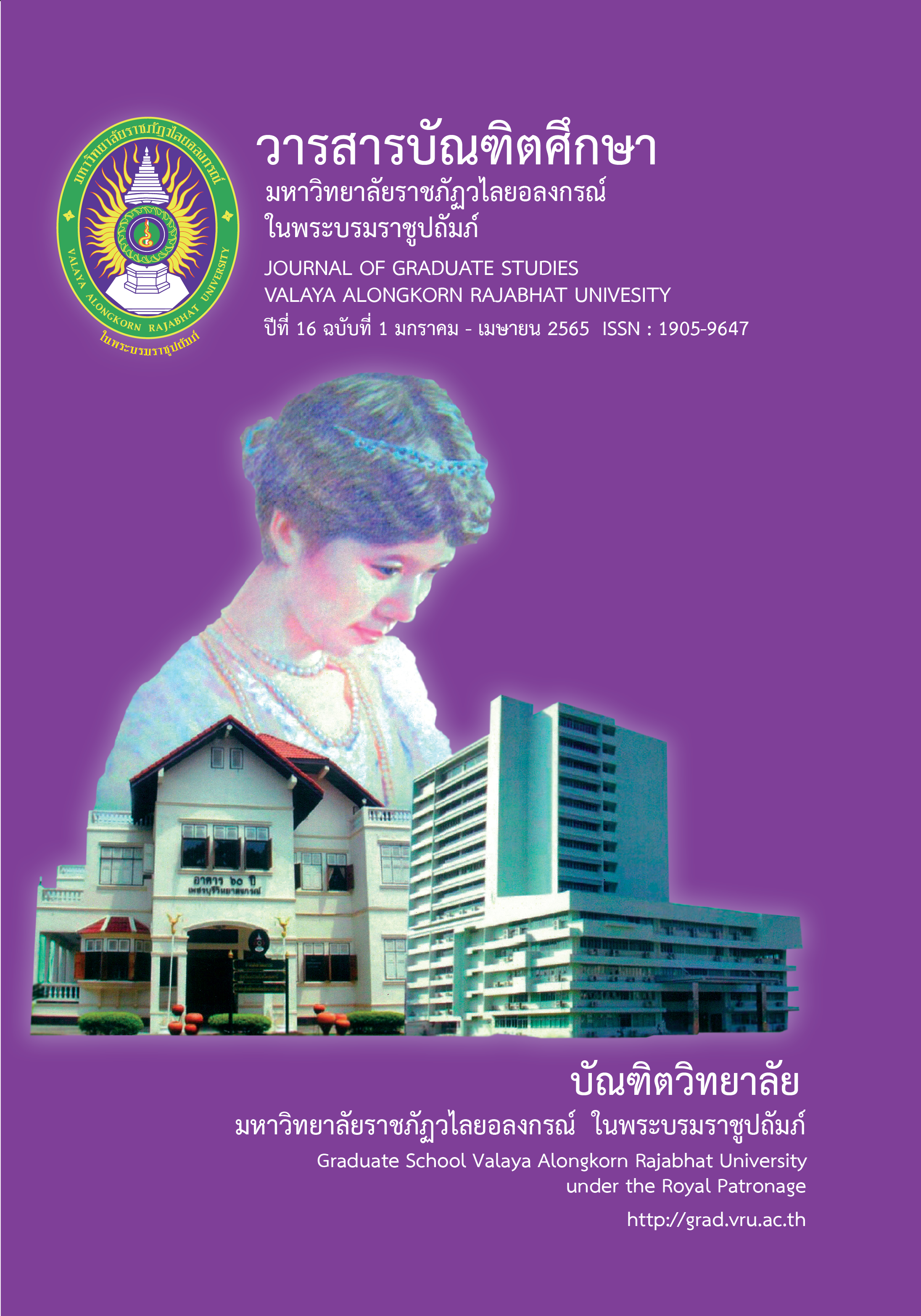CURRENT SITUATION OF CHINESE LANGUAGE TEACHING-LEARNING MANAGEMENT: LEARNERS' VIEWS TOWARDS LANGUAGE INSTITUTE DEVELOPMENT
Main Article Content
Abstract
The purposes of this research were to 1) study the current state of Chinese language teaching and learning management of the Center for Asian Languages and Cultures, Institute of East Asian Studies, Thammasat University, and 2) present the data obtained as a guideline for the development of Chinese language teaching and learning management. This study employed questionnaires as a tool. The sample consisted of 89 students enrolled in the Chinese language courses of the language institute during semester 1/2020. Simple random sampling was conducted. The statistics used included frequency distribution, percentage, mean and standard deviation and content analysis from open-end questionnaires.
The results of the research were as follows: 1) Overall, most respondents agreed that the teaching and learning management in the area of instructors was at the highest level, while other components had an average score at a high level, including the supporting factors of teaching and learning, the process of teaching and learning, curriculum, and learners, respectively. Suggestions from open-ended questions that the respondents valued the most were an increase in learning-enhancing external activities, regarding Chinese culture. These would be organized in addition to the ones conducted in the classroom, and help the learners to apply the language use in real life situations. 2) The recommendations from this research are as follows: expanding the courses that meet learners’ need, developing extra-curricular activities relate to Chinese culture, seeking for the MOU with educational institutes from China in order to develop exchange programs in the area of teachers, students, and friend-matching via social media, providing electronic media apart from textbook, and increasing new channels to promote the Center for Asian Languages and Cultures.
Article Details

This work is licensed under a Creative Commons Attribution-NonCommercial-NoDerivatives 4.0 International License.
บทความทุกเรื่องได้รับการตรวจความถูกต้องทางวิชาการโดยผู้ทรงคุณวุฒิ ทรรศนะและข้อคิดเห็นในบทความ Journal of Global of Perspectives in Humanities and Social Sciences (J-GPHSS) มิใช่เป็นทรรศนะและความคิดของผู้จัดทำจึงมิใช่ความรับผิดชอบของบัณฑิตวิทยาลัย มหาวิทยาลัยราชภัฏวไลยอลงกรณ์ ในพระบรมราชูปถัมภ์ กองบรรณาธิการไม่สงวนสิทธิ์การคัดลอก แต่ให้อ้างอิงแหล่งที่มา
References
Akakul, T. (2000). rabīap withī wičhai thāng phrưttikam sāttra læ sangkhommasāt [Research methodology in behavioral sciences and social sciences]. Ubon Ratchathani: Ubon Ratchathani Rajabhat University.
Chokdeemeesuk, K. (2015). kāntē rī yom khwām phrō̜m dān phāsā Čhīn nai kānkāo khao sū prachākhom sētthakit ʻĀsīan [The Preparation of Chinese Language to be ready for ASEAN Community]. HCU Journal, 19(37), 153-161.
Institute of East Asian Studies, Thammasat University. (2018). rāingan pračham pī Phutthasakkarāt sō̜ngphanhārō̜ihoksipʻet [Annual Report 2018].
Javisoot, N. (2012). kānčhatkān rīan kānsō̜n laksūt sinlapa sāt bandit sākhā wichā phāsā Čhīn khana manutsayasāt mahāwitthayālai sī nakharin wirōt tām khwāmkhithen khō̜ng nisit [Instructional management in Bachelor of Arts Program in Chinese, Faculty of Humanities, Srinakharinwirot University as perceived by students]. Master Thesis, M.A. (Education Administration). Bangkok: Srinakharinwirot University.
Khammanee, T. (2014). pluk lōk kānsō̜n hai mīchīwit sūha ʻong rīan hǣng satawat mai [Awaken the world of teaching to live in a new century classroom]. Bangkok: Sahamit Printing and Publishing Company Limited.
Khamta, J. (2015). kānsưksa khwāmsamphan rawāng phrưttikam kānsō̜n khō̜ng ʻāčhān kap phrưttikam kānrīan khō̜ng naksưksa khana bō̜rihān thurakit sathāban theknōlōyī Thai - Yīpun [A Study of the Relation between Teaching Behaviors of teacher and Learning Behavior of StudentsFaculty of Business Administrationat Thai-Nichi Institute of Technology]. Veridian E-Journal, Silpakorn University, 8(2), 1528-1542.
Office of the Education Council. (2016). rāingān kānwičhai phư̄a phatthanā rabop kānčhatkān rīan kānsō̜n phāsā Čhīn nai prathēt Thai: kānsưksā nō̜k rabop [A research report for the development of the Chinese language teaching and learning management system in Thailand: The Case of Non-formal Education]. Bangkok: Prigwhangraftfic Co Ltd.
Office of the Basic Education Commission, the Ministry of Education. (2014). nǣo patibat tām prakāt krasūang sưksāthikān rư̄ang nayōbāi kanpatirū kān rīan kānsō̜n phāsā ʻAngkrit [Guidelines from Ministry of Education’s Announcement about English Pedagogy Reform Policy]. Bangkok: Chamchuree Products Co Ltd.
Ruankaew, S. (2009). khwāmsamkhan khō̜ng phāsā Čhīn nai patčhuban [The importance of present Chinese language]. Retrieved from http://ning-50010110079.blogspot.com.
Siriphan, R. (2018). nǣothāng kāntē rī yom khwām phrō̜m læ withīkān rīan samrap phū rœ̄m rīan phāsā Čhīn [Techniques for Developing Chinese Skills for Beginners]. Journal: Princess of Naradhiwas University Journal of Humanities and Social Sciences, 5(1), 103-112.
Sriyanalug, K. (2016). kānchai sư̄ theknōlōyī sārasonthēt nai kānrīanrū phāsā Čhīn dūai tonʻēng khō̜ng nisit khana manutsayasāt læ sangkhommasāt mahāwitthayālai būraphā [Using Information Technology for Chinese Language (Mandarin) Self-Learning in Students from Faculty of Humanities and Social Sciences at Burapha University]. Humanities and Social Sciences, Burapha University, 24(46), 1-17.
Starut, A. (2013). kānčhat saphāpwǣtlō̜m nai sathān sưksā khō̜ng rōngrīan sangkat Krung Thēp Mahā Nakhō̜n samnakngān khēt rāt thēwī [The Environment Management in the schools Ratchathewi District, Metropolitan Administration]. M.Ed. (Educational Administration). Bangkok: Graduate School, Srinakharinwirot University.
Teerawakin, L. (2006). botbāt khō̜ng prathēt Čhīn læ phāsā Čhīn nai satawat mai [The role of China and Chinese in the new century]. Retrieved from https://mgronline.com/daily/detail/9490000074640
Thatthong, K. (2007). kānphatthanā laksūt thō̜ngthin [Curriculum development for local]. Nakhon Pathom: Phetkasem Printing Group Co., Ltd.
Wasinanont, N. (2016). kānsưksā saphāp kānčhatkān rīan kānsō̜n phāsā Čhīn radap ʻudomsưksā nai prathēt Thai [The Study of Thailand’s Systematic Chinese Teaching Management if Higher Education]. Chinese Studies Journal, 9(2), 263-264.
Wisedjinda, J. (2017). nǣothāng kānčhatkān rīan kānsō̜n phāsā Čhīn radap matthayom tō̜n plāi [Guidelines for Chinese Instruction in Upper Secondary Schools]. (Master’s thesis). Bankok: Chulalongkorn University.


